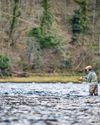
Ash is one of those tree species that is much beloved by the nation – a national treasure. It has been nurtured for centuries by woodland owners and managers as a reliable timber crop. It is used extensively by furniture makers and craftsmen, praised by nature lovers for the extraordinary range of biodiversity it can sustain, and enjoyed by the public for its sheer aesthetic beauty and the grace it brings to any wooded landscape. However, the first indication that all was not well in our ash woodlands came in 2012 – just seven years ago. Ash dieback – a fungal pathogen initially known as ‘chalara’ but now recognized as Hymenoscyphus fraxineus – was reported on young trees imported into nursery stock from mainland Europe. That stock was quickly destroyed. But then came further discoveries and, although first reported in 2012, there is now strong evidence that ash dieback was present in the UK before that date, undetected.
Tracing the disease further back, it first emerged in Poland in the early 1990s and has spread through many European countries, killing ash trees in their millions – 90% of those in Denmark have died.
It is spread both on imported stock (now banned) and is carried by the wind. Since 2012, it has spread east to west across the UK, and can now be seen in almost every county of England and Wales and across Eastern Scotland. Young ash is particularly susceptible but in the past few years, it has become obvious that older, mature ash is also falling victim.
This story is from the {{IssueName}} edition of {{MagazineName}}.
Start your 7-day Magzter GOLD free trial to access thousands of curated premium stories, and 9,000+ magazines and newspapers.
Already a subscriber ? Sign In
This story is from the {{IssueName}} edition of {{MagazineName}}.
Start your 7-day Magzter GOLD free trial to access thousands of curated premium stories, and 9,000+ magazines and newspapers.
Already a subscriber? Sign In

Rory Stewart - The former Cabinet minister and hit podcast host talks to Alec Marsh about the parlous state of British politics, land management and his deep love of the countryside
The gently spoken 51-year-old former Conservative Cabinet minister is a countryman at heart. That's clear: he even changes into a tweed waistcoat for the interview, which takes place at his London home and begins with a question about his precise career status. Having resigned from the Commons and the Conservative Party in 2019, the former diplomat and soldier has reinvented himself, first with an unconventional but promising run as an independent for the London mayoralty (abandoned because of COVID19 in 2020) and then as a media figure, co-hosting one of the country's most popular podcasts, The Rest Is Politics, alongside Alastair Campbell, the former Labour spin doctor.

Fodder
Local fare with the feel-good factor.

Celebrating the game changers
Once served only in the traditional manner, the fruits of our forays now find their way into all manner of diverse and delicious dishes, say Neil and Serena Cross

The first civil engineer
John Smeaton left an indelible mark on the field of engineering and, three centuries after his birth, his legacy remains as strong as ever

School spirits
From grey ladies and ghostly gardeners to more malign entities, public schools are a rich repository of unnatural phenomena

'A long way from Piccadilly or Pall Mall'
Marking 150 years since the birth of Sir Winston Churchill, Dr Conor Farrington explores this eminent statesman’s often-overlooked 1907 tour of British East Africa: a journey rich with enchanting natural beauty and sporting adventure

Top of the pups
Canines in all their guises were celebrated at The Field Top Dog Awards lunch at Defender Burghley Horse Trials whether eager on the peg, patient at home or perpetually making mischief

Angling for success
It’s never too early to shape up for next season’s salmon and trout, and these top fishing schools are here to help

Talking scents
The canine nose is an astonishingly complex piece of biotechnology that man has harnessed for sustenance and sport for thousands of years

Wall-to-wall excitement
Criss-crossed by formidable drystone walls, the High Peak Harriers’ scenic country provides a day out with an exhilarating difference